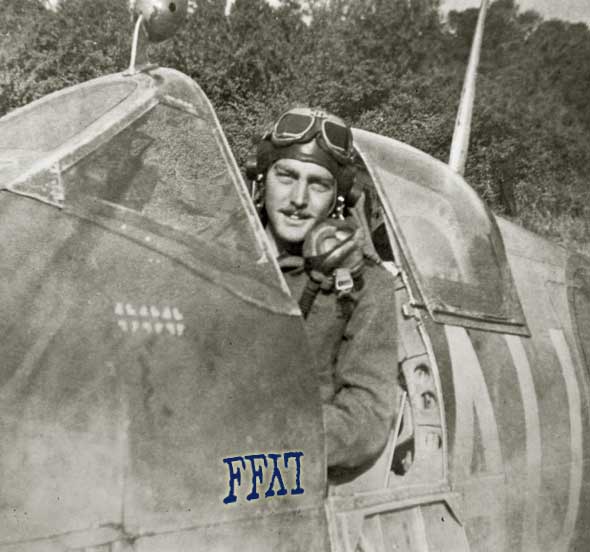|
--------------------------------------------------
John Norman Paterson
"John came to Bishop's in September of 1936. The youngest man in his year, and for this reason still rejoices in the names of '"Sonny" and "The Kid". In his first year, he played football with the Intermediates until he was put out of action with a broken wrist. That winter saw the birth of the famed Paterson, Goff, Paterson line on the hockey team, which has been going strong ever since. Sunday morning would see Sonny in company with other non-Anglicans heading for North Hatley for a little skiing, and a change of diet.
In his second year, he dropped football and took up golf ... not very seriously, just for the exercise. That year he also joined the C.O.T.C., and passed his practical examination. The hockey season saw him again (even flashier than the previous year), at center ice. He took up badminton and has been playing in College matches ever since.
In his third year, he played football, hockey and even entered into Dramatics, receiving the part of a silent Indian servant. As a side line he studied enough to pass, and this year will graduate in History and Philosophy, going to Toronto next year for Law. |
|
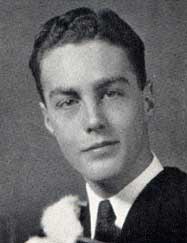 John Paterson
John Paterson |
The Kid will he missed by the whole College and, in particular, by the hockey team and a select group of co-eds."
Quoted from John's 1939 yearbook from Bishop's University in Lennoxville, Quebec
--------------------------------------------------
Born 22 August 1920.
Son of senator Norman McLeod Paterson.
Home in Fort William (Thunder Bay) Ontario.
Enlisted in Fort William in 1940.
Commissioned 4 January 1941 (J3521).
Instructed in Canada until February 1943.
Posted to the UK.
Assigned to 421 Squadron.
A Flight Commander of 421 during summer of 1944.
Tour expired.
Returned to Canada in September 1944
Released from the RCAF, 6 December 1945.
Post war he bought a Spitfire which he flew until he
donated it to the Canadian Aviation Museum
where it can be seen today (see photo below).
The CAM also acquired a Stearman from John. |
--------------------------------------------------
Hamilton Flier Gets 3 As RCAF Bags 9 Huns
An R.C.A.F. Base In England, June 15, 1944 — (CP) — A Canadian Spitfire squadron racing over the Caen area of the Normandy Beachhead in support of Allied troops locked in battle on the ground tore into a formation of 20 ME-109's today and blasted nine of them out of the sky. Another was damaged.
The squadron was led by F/L J. F. McElroy of Port Arthur, Ont, and Kamloops, B.C.
A general melee developed when the Canadians sighted the Germans flying directly toward them at 15,000 feet. Before the brief, vicious action ended, F/O J. N. Bamford of Hamilton, Ont., destroyed three enemy planes; F/L J. N. Paterson, Toronto, and F/O W. Warfield, Tudo City, N.Y., each got two; and F/L W. N. Stronach and F/O W. F. Cook, Trenton, Ont., each got one.
McElroy was credited with a probable and F/L E. D. Grant, Coniston. Ont., with a damaged enemy plane.
McElroy and F/L B. T. Gilmour, St. Thomas, Ont., crash-landed in France during the action, but word was received at this base tonight that both are safe.
Bamford's kills were a model of unwasted, lethal action. He went first for a Messerschmitt that had another Spitfire on its tail and sent the Nazi spinning to the ground with strikes on the engine from 150 yards. He sighted a second to starboard as he broke from the first fight and set this plane afire in a swift attack.
As he was diving after this victory, a third ME-109 cut across his path and Bamford poured bullets into him as he followed him down. He watched the German hit the ground. Bamford pulled out of his dive almost at ground level with his Spitfire going more than 400 miles an hour.
Most of the other pilots scored their victories almost as quickly, but Grant's cannon jammed when he had a Nazi cold and he had to follow him almost to the ground and chase him 20 miles before breaking off combat because he was out of ammunition.
--------------------------------------------------
F/L PATERSON DESCRIBES FLAMING FIGHT AGAINST THIRTY FIVE HUN PLANES
The Paterson News, Vol.1 No.2., November 1944 - "It wasn't much … I guess I got three Huns …” Such was the way F/L John N. (Pat) Paterson, 24-year- old son of Senator and Mrs. Paterson dismissed his flying record when he returned to Ottawa after completing 120 operational sorties over Europe. It was not, however, the story probed from the friendly, unassuming fighter pilot by an Ottawa Journal Reporter.
The "wasn't much" was plenty … and there was no guesswork about the three Jerries he blew out of the smoking Normandy sky. "Pat" was not a man to talk about himself ... "What do you want to know all that stuff for? It was nothing, really." Good-naturedly he answered the questions fired at him. He unfolded the story of a quiet young law student who laid aside his mortar-board and gown in exchange for a flying suit and subsequently, in a flaming air fight in which the odds were 35 to 12 in favour of Hitler's henchmen, carved his name in the list of Canada's air heroes.
 F/L J. "Pat" Paterson
F/L J. "Pat" Paterson |
|
He is the second son of Senator Paterson to achieve a notable air record, for his brother F/L Don Paterson, a bomber pilot in Britain is the holder of the Distinguished Flying Cross. After graduating from Bishop's University in 1939, and completing a year of his law course in Toronto, the young pilot went to his native city of Fort William to enlist in the R.C.A.F. He received his wings in 1940, and instructed in Canada for two years. Tiring of routine, he applied for an overseas post and after a course in Britain, went on fighter patrol in Spitfires in August 1943. On his first trip he had a "shaky do", meeting a Messerschmitt 109. They exchanged shots, neither one scoring, and then the Hun high-tailed it for home. He didn't get far, however, for the pilot in No. 1 position, (Pat was No. 2) managed to get in a burst that blew the German to bits.
For months, "Pat" continued escort and patrol work without actually tangling with the enemy. Then came the big day last June when, flying over Caen with 12 planes of the famed Red Indian Squadron, he fought his first real air battle. |
"We had gone over the coast of Normandy on patrol, F/L John McElroy of Kamloops was leading us. I was going along at about 8,000 feet when McElroy spotted a big formation of Jerries." The "DR" intercommunication system crackled. The Canadian pilots sat up sharply in their cockpits while McElroy's voice came to them. "There they are. They're all 109's. Get into them boys!"
Pat looked up and saw the Huns. There were 35 of them. "I was scared green", he admitted flatly. "Anyway, we started climbing as hard as we could. At the time, McElroy and seven of the Red Indians were flying several thousand feet above Pat and three companions who had been assigned to "work on the floor". It was a long climb for the latter four.
"Then I passed 10,000 feet, five Huns already had gone tearing down past me in flames. Then the Jerries started to work on us chaps who were coming up from below. They came in groups of four or five. All we could do was turn sharply to meet them as they approached us in a wide arc. Luckily, they all missed us. He climbed and then the other three chaps with me broke off and chased a group of Huns that had taken a crack at us. My No. 2 man shot one down. I kept on going up and finally found myself above everybody. Then I saw a group of eight German planes swinging around below me. The sun was behind me and in the mix-up they didn't see me." It was then that Pat put into effect the tactics attributed by Hollywood to Sergeant York of First Great War fame. York was said to have reached his high score of dead Germans by starting at the last man so the others wouldn't miss him.
Pat chose the hindmost Hun, "poured on the coal" and came howling down from a terrific altitude with his guns aflame. Two cannon and four machine guns ripped the German to ribbons and he fell away. Pat pulled back on his stick and in a few seconds had regained his lost altitude. The other seven Germans in the meantime had made a circle, apparently intent upon the milling planes below them and waiting for a Canadian straggler to provide them with "easy meat". They waited too long, however, down came F/L Paterson a second time and again the rear Hun received a blast of hot steel. He went down tumbling like a dead bird. F/L Paterson had the good fortune to see both his kills hit the earth and they were also seen by some of his mates. "The two other squadrons, who were on patrol with us were coming in at full tilt and shouted on the radio to leave something for them to play with, but the remaining Jerries were beating it for Der Faderland. We shot down 10 and lost only one plane. The pilot landed by parachute and is a prisoner of war in Germany." (Lorne F. Curry killed. Two more Spits were written-off after landing -jf)
In the following month F/L Paterson shot down a German reconnaissance plane and later, Pat had the rudder almost shot off his machine, but was able to stay in the air. In addition to the three aircraft, F/L Paterson ran up a sizeable score in ground strafing operations. "The despatch riders are easy to get because they don't hear you coming. You just get them in your sights and Wham! - They arre gone."
Pilots don't attempt to strafe standing automobiles or convoys. "You have to come at them head on for a long distance, so while you have them in your sights, you also present them with a steady, head-on target. Many a man has been shot down that way. Even rifle or revolver fire can bring down a plane if it should hit the radiator."
Describing his feelings, F/L Paterson said the first feelings of fear melted when he shot down the first German. "This is a piece of cake", I thought, "I’m going back to get another." On many occasions Paterson had brief, passing skirmishes with large groups of German planes. "You pass them so fast, you just have them in your sights for a fraction of a second. You give them a squirt and they take a squirt at you. You never know whether you hit
them or not ... Then they are gone."
He hopes to return to the fighting front, perhaps the Far East, when his leave is ended.
--------------------------------------------------
Victories Include :
15 June 1944
16 July 1944 |
one Me109
one Me109
one Me109 |
destroyed
probable
destroyed |
&
Caen Area (MJ820)[1]
Caen Area (MJ820)[2] |
2 / 1 / 0
[1] "... yellow section climbed to join rest of squadron and we got into a large gaggle of enemy aircraft at 13,000 feet. I fired at a Me 109 from about 350 yards with 15° to 20° deflection, strikes were observed on cockpit and wing root followed by smoke and flame. I orbited and saw him crash. I followed the gaggle around again and picked another 109 firing from 400 yards down to 250 yards. I saw strikes on his wing root, engine and cockpit again followed by smoke and flame. The enemy aircraft was trembling and flicking and on fire when last seen going down.''
[2] "... After flying for nearly an hour Planet (ground control) radioed Cradle that there was a bogey at angels eight, vector 040. Paterson noted the time at 1820 hours and dove to the attack:
"Sighted enemy aircraft at 8,000 feet on port side on reciprocal heading. Chased enemy aircraft and closed to about 200 yards at 6,000 feet just over Curpiquet Aerodrome - gave enemy aircraft a 2-second burst of machine guns and cannon after identifying him as an Me 109. Large pieces fell off and clouds of white smoke came back. Enemy aircraft rolled slowly to right and crashed in flames about a-mile-and-a-half south-west of the aerodrome. F/O Libbey, my number two, saw the pilot bale out at 5,000 feet and the crash was seen by F/O Libbey, F/O Smith and F/O Holness."
It was a reinforcement unit that appears to have been the target of Paterson's attack. II./JG 52 was sent into Normandy with instructions to turn over its pilots and aircraft to JG 3. In this, their first appearance in Normandy. II./JG 52 lost three pilots and machines and two of them are believed to have been lost in the Caen area — one early in the morning and the other around 1800 hours. If this assumption is correct then Paterson shot down either Leutnant Hermann Kelkel KIA or Feldwebel Heinz-Otto Birkenfeld FTR - most likely the former."
The above quoted from "Angels Eight" by Dave Clark
--------------------------------------------------
Spitfire NH188
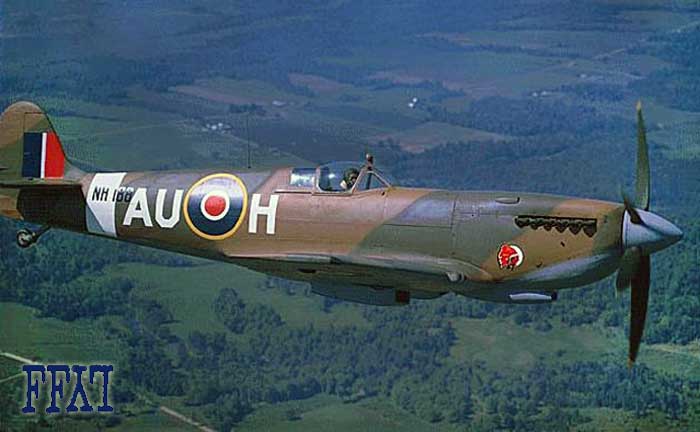
Paterson's Spit on it's way to the Canadian Aviation Museum in Ottawa in 1964
This Ontario Businessman “Finds An Old Friend”
His War Memento Is A Spitfire
The Telegram, Toronto, Friday, March 16, 1962 - FORT WILLIAM — (Special) — Most wartime flyers, when overcome with a twinge of nostalgia, are able to dredge up from their catchall closets only a tattered log book, a grotesque oxygen-masked helmet or real RAF issue flying boots.
John Paterson, 41, vice-president and general manager of N. M. Paterson and Sons (ships and grain elevators) also has a souvenir to remind him of his wartime days when he shot down three German ME-109s. It's a REAL Spitfire and he flies it with thunderous 400 mph pride to the awestricken amazement of Port Arthur-Fort William residents.
After nearly a quarter of a century, which has seen the advent of H-bombs and space rockets, the Spitfire is still enshrined in the hearts of English-speaking people as the saviour of freedom in turning back Hitler's Luftwaffe. |
|
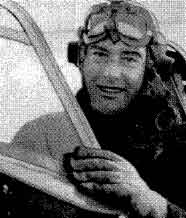
John in his Spitfire |
REAL THOROUGHBRED
And for the men who flew the Spitfire their highest tribute was that the trim, little ship was a real thorough bred.
The discovery and renovation of the Spitfire Mr. Paterson flies, is a saga comparable to finding Man O'War pulling a milk wagon, and returning that famous racehorse to an honored pasture.
Mr. Paterson's 10-year search for his aerial thoroughbred ended in Belgium where he was able to buy "at a fair price" a doughty old wartime warrior retired from the drudgery of towing target drogues. The "Spit," a Mark IX model with clipped wing tips, was dismantled, crated and shipped to Thunder Bay Flying Club of which Mr. Paterson is a member.
But the restoration job was just beginning.
Ron Kyle, 27, chief engineer at the club, had never even seen a Spitfire. He was only five when the Battle of Britain was fought.
Mr. Paterson's father, a Canadian senator, helped persuade the British Air Ministry to part with its last, once top-secret Spitfire manual.
A Canadian oil company, after a thorough search of a warehouse, came up with some dusty cans of glycol, a now rare radiator coolant.
Mr. Paterson managed to buy an unused Rolls-Royce Merlin 24-cylinder engine and after hundreds of hours in preparation, the Spitfire was ready for a trial taxi run early this year.
IT'S AIRBORNE
But, once on the runway, a bad crosswind required a sudden gunning of the 1,375-hp engine to keep the little craft straight. The Spitfire, as Mr. Paterson explained to a doubtful Department of Transport inspector, got its head and they were airborne.
"It was hair raising," he explained of the impromptu 20-minute flight
Did he miss the gunsight, the two cannon and four machine guns?
"No, not really," smiled Mr. Paterson who was a flight lieutenant with the RCAF's 421 Fighter Squadron.
The Spitfire is presently a sky blue color but there are hopes of having it refurbished with wartime camouflage.
Already offers to perform are coming in. He has one from Barrie for next year's winter carnival. And the National Air Museum at Ottawa has asked to have the Spitfire as a museum piece when he is through with it.
AN OLD FRIEND
But, if he does eventually part with his old friend, it won't be for some time. Even at $50 worth of gas per two-hour flight, he is having too much fun flying it.
"The Spitfire is a kind airplane," Mr. Paterson relates. "The technique of flying it came back very quickly. It was very thrilling.
"I am going to keep it until I can't fly it any longer."
--------------------------------------------------
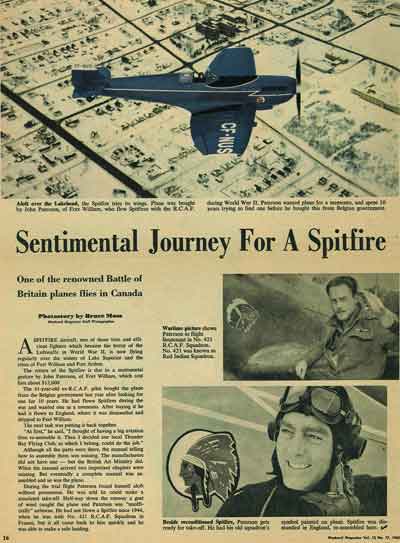
Another Similar article. Click it to read it
--------------------------------------------------
Check out John's (bomber pilot) brother Don, here
--------------------------------------------------
|



